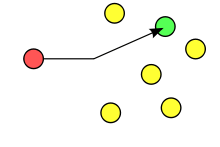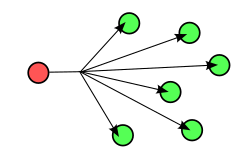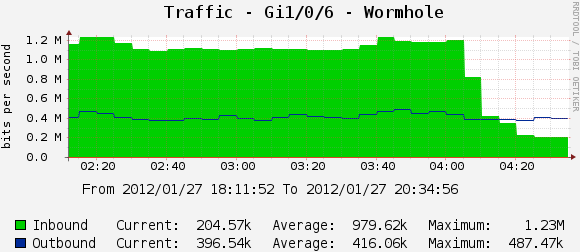Unicast flood
In computer networking, a unicast flood is when a switch receives a unicast frame and treats it as a broadcast frame, flooding the frame to all other ports on the switch.
Background
The term unicast refers to a one-to-one transmission from one point in the network to another point. Conventionally, unicast is considered more secure because the frame is delivered solely to the intended recipient and not to multiple hosts. This diagram illustrates the unicast transmission of a frame from one network host to another:

When a switch receives a unicast frame with a destination address not in the switch’s forwarding table, the frame is treated like a broadcast frame and sent to all hosts on a network:

Causes
The learning process of transparent bridging requires that the switch receive a frame from a device before unicast frames can be forwarded to it. Before any such transmission is received, unicast flooding is used to assure transmission reach their intended destination. This is normally a short-lived condition as receipt typically produces a response which completes the learning process. The process occurs when a device is initially connected to a network, is moved from one port to another or after 5 minutes of inactivity when the device is typically purged from the forwarding table.
A switch that has no room left in its address cache will flood the frame out to all ports. This is a common problem on networks with many hosts. Less common is the artificial flooding of address tables—this is termed MAC flooding.
Another common cause are hosts with ARP timers longer than the address cache timeout on switches—the switch forgets which port connects to the host.[1]
Devices other than switches may create unicast floods as well. A router which has a bridge interface but does not have the destination frame's address in the bridge cache will flood the frame out to all bridge members.[2]
Misconfigured features of the networks may lead to unicast flooding as well. If there are two layer 2 paths from Host A to B and Host A uses path 1 to talk to Host B, but Host B uses path 2 to respond to Host A, then intermediate switches on path 1 will never learn the destination MAC address of Host B and intermediate switches on path 2 will never learn the destination MAC address of Host A.[3]
A final cause of unicast floods are topology changes. When a link state changes on a network port which participates in rapid spanning tree, the address cache on that switch will be flushed causing all subsequent frames to be flooded out of all ports until the addresses are learned by the switch. [4]
Remedies
There are several remedies discussed in the links above. But for many situations, a low end switch needs to be replaced with a higher end switch—one that has a larger address table and one that can block unicast floods. Blocking unicast floods on a Cisco switch is easy to do, but it is not enabled by default. After ensuring that timeouts and/or security features have been configured to maintain table entries on client access ports longer than typical host ARP cache timeouts, this command is used to quiet down the unicast floods on those ports:[5]
Switch(config-if)# switchport block unicast
Other techniques involve isolating hosts at Layer 2, which blocks intra-LAN communication not destined to the router. A handy tool (available in lower end switches[6] ) is the
Switch(config-if)# switchport protected
or a more robust, cross-switch solution than 'switchport protected' is the use of Private VLANs.[7]
Effects on Networks
When a network is experiencing unicast flooding, network performance is degraded. Here is an graph of a bridge before and after adjusting the size of the bridge address cache:

80% of the frames were flooded out never to be received by the destination address, while 20% was valid traffic (image from first reference). In high volume networks, the flooded traffic may cause ports to saturate and lead to packet loss and high latency.
Another side effect of exhausted address tables is the compromise of data. The security considerations are discussed in the MAC flooding—one of several causes of unicast floods. If an end user is running a packet sniffer, the flooded frames could be captured and viewed.
References
- Steven King (2009-06-17). "Unicast Flooding". Retrieved 2012-01-27.
- Rudy Rucker (2012-01-27). "Fix for unicast flooding". Retrieved 2012-01-27.
- "Elimination of Asymmetric Forwarding and Unicast Flooding". Cisco Systems Inc. Retrieved 2012-01-27.
- Balaji Sivasubramanian (2004-09-10). "Troubleshooting Unicast Flooding Due to Topology". Cisco Press. Retrieved 2012-01-27.
- Jeremy Stretch (2010-06-04). "Blocking Unknown Unicast Flooding". PacketLife.net. Retrieved 2012-01-27.
- Petr Lapukhov (2008-07-14). "Private VLANs Revisited". Retrieved 2012-04-07.
- "Configuring Private VLANs". Cisco. Retrieved 2012-04-07.